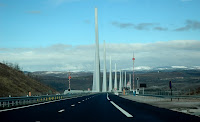
Last night we decided to choose from the a a carte menu at the restaurant - just to round out the experience following our choice from the 80s celebration menu yesterday. We had been trying to get a copy of the celebration menu so we could write down our choices for the blog (having forgotten to do it yesterday). 

One of the young waitresses kindly put us out of our misery trying to copy from Spanish by giving us a copy of the menu book that has been produced. This includes all the recipes for the regional specials being served.
Looking through it, and remembering the meal yesterday, we could see lots of possibilities for future uses ;-) I then realised that this was book no 3 and we planned to ask her if there were spare copies of books 1 & 2 still available when tonight's hors d'oevres were served. (Later, one of the waiters seeing us reading avidly through the copy we have, brings us a copy of the first two without having to be asked - now that is service!)
For hors d'oevres tonight we are presented with a silver spoon on which is a 2 cm square of local chevrè topped with a half cherry tomato (not fully ripe) and a perfect walnut half - it is SO good. At the same time I have an aperitif of a local sparkling wine handed to me while Michael has to do with a mineral water!
For entreès Michael chose Seafruits and Garlic Bread Soup and I have Mushroom Cream with Egg. They are both luscious. Michael's bread floats atop the soup. My soup has a perfectly poached egg drizzled with olive oil and sprinkled with chives in it. Now, that egg just perfected the soup. It gave it a light richness as the yolk broke into the thick brown soup.
The mains are Loins of Sea Bass with Fennel and Tomatoes Grille (Michael) and Grilled Lamb with Milfoil of Potatoes (Me). Both were just superb. Dessert then followed and we agonised over the choices. In the end Michael got the Caramel Cream encased around a fine Mint Jelly and Praline Icecream and I have the Dark and White Chocolate Mousse which is studded with drained dark cherries and accompanied by the tightest marbled chocolate log rolled about 5 inches long. We actually argue over which is the better and grudgingly give each other a taste of ours. The jury is still out!
Once we finish dinner with a digestif local Muscat for me with coffee and a bitter Columbian coffee for Michael we return to our suite. When we get back up there, we realise that it is almost 11pm! Gosh - it is hard to get used to the time here when meals are taken so late.
This morning we head down to breakfast at 9:45 am but most people don't come in until well after 10am. One of the local breakfast dishes is to rub pieces of bread (firmer than what we usually have at home) roughly with a cut tomato, drizzle it with olive oil and top with wickedly good Iberian Jambon (smoked ham - very dry, VERY good) and then anchovies. Nice, but in our humble opinion, the tomato is wasted - they would be better to slice the tomato and eat it as well!!
After breakfast we re-pack our stuff and in the drizzle from very low cloud swirling around the castle, we make our goodbyes - having given out yet another of our cards!
We head south for the Barcelona and the coast. Although it is wet, it is not cold and the car thermometer says it is 8 degrees outside. It is less than 90 kms to Barcelona and we make it in good time, again using the directions from Google Maps. Once in the City though, the directions seem less useful as streets are one way (the wrong way of course!) and named differently than on the directions. Using both the directions and our AA road map for Europe (which has a Barcelona Cit Map) we try to find the agency where we need to collect the key for the apartment we have booked for the week.
A frustrating 2 hours of going this way then that and I pull over to telephone them. Now, you might ask why it took so long to stop and phone - try finding ANYWHERE in Barcelona to pull over! We are just a few blocks from where we need to be - and have driven past the building twice already without realising it. The directions named a small street that is actually a laneway behind a closed iron gate! Still - all is good and we get directions to the unit Dali II. We find where we need to be very easily but as you can guess, parking is another matter altogether. We finally park in an underground station approximately 200 m from the unit at the crazy price of €34 a day! I phone the office and ask for alternatives only to be told that all parking stations are about this price. Tomorrow, first stop is the Tourist Information Office to ask their recommendation.
And the rain is setting in!

The apartment is on the centre of the area known as the Sant Marti and just off the Port Vill. We are within walking or a short bus trip from all the main tourist spots including the Gaudi architecture and La Sagrada Família. The unit is on the 5th floor at Plaça de Colón 5, 4-2, Barcelona, Spain - put it in to Google Earth to see what a great location we have!

















































